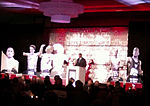Herbert Irving Comprehensive Cancer Center
1911 establishments in New York CityColumbia UniversityHospitals in New York (state)NCI-designated cancer centers
Herbert Irving Comprehensive Cancer Center (HICCC) is a National Cancer Institute NCI-designated Cancer Center, founded in 1911 and located at NewYork-Presbyterian / Columbia University Irving Medical Center (NYP/CUIMC). The HICCC has more than 250 faculty members, 12 core facilities, and eight research programs within three divisions.
Excerpt from the Wikipedia article Herbert Irving Comprehensive Cancer Center (License: CC BY-SA 3.0, Authors).Herbert Irving Comprehensive Cancer Center
West 165th Street, New York Manhattan
Geographical coordinates (GPS) Address Nearby Places Show on map
Geographical coordinates (GPS)
| Latitude | Longitude |
|---|---|
| N 40.8409 ° | E -73.9433 ° |
Address
Herbert Irving Pavilion
West 165th Street
10032 New York, Manhattan
New York, United States
Open on Google Maps








